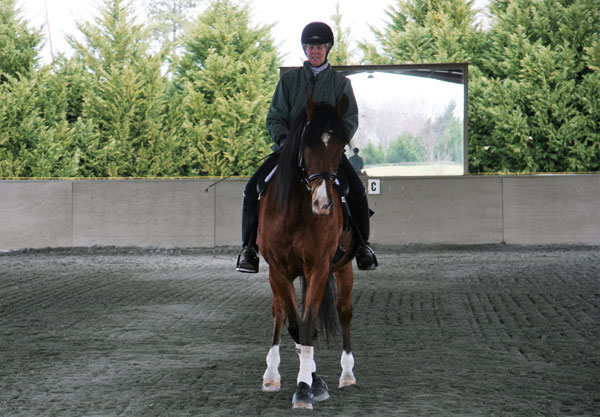One comment I often make to my scribe is: “Crossed legs into halt.” This most often occurs at the start or end of a test at Training and First Levels, although it can happen at any level and from any gait. What it usually means is that the rider has pulled on the reins too much going into the halt. The result is to send the horse onto his forehand and he crosses his front legs in an effort to regain his balance.

What the judge would really like to say in this instance is: “Rider uses more hand than leg into the halt, so horse braces against bit, leans into his shoulders and thus crosses his front legs in an effort to stay upright.” A halt where this happens is not going to score above a 6, at best. Obviously, that kind of comment would be a scribe killer, so the judge has to use the shorthand of “crossing front legs.” The problem is that riders never see that crossing from where they are sitting and thus might be perplexed about the comment, not to mention the score.
If you ever get this comment, try riding your halts toward a mirror. If you don’t have access to a mirror, then ride your halts toward someone who can watch you. You may be surprised how often your horse is crossing his front legs when you go from trot or walk into halt. Ideally, you shouldn’t have to do more than just close your fingers and then use a light leg aid to ride up into that connection. If you have to apply any more muscle than that, or if you find yourself “putting your feet on the dashboard” in a transition to halt, it’s a safe bet that you’re forcing your horse onto his forehand.
One exercise to improve this inclination is to do a series of halts as you ride around the ring, first at walk and then at trot. Each time you halt, attempt to reduce the amount of hand you need by half while increasing your leg aids slightly. The instant the horse halts, relax your arm.
Be sure to also ride down the quarter lines and then the centerline of your ring and practice halts there as well, because you often need more hand/leg aids when away from the stability of the wall. Thus, what works along the track may not work as well on the centerline, where you will be doing the halt straight toward the judge. Do the halts at various locations on the centerline and intersperse by riding the centerline with no halts at all so the horse doesn’t start to anticipate or get anxious.
In addition to improving the halts, these exercises should help engagement overall, and you may find your horse is in a better uphill balance.











